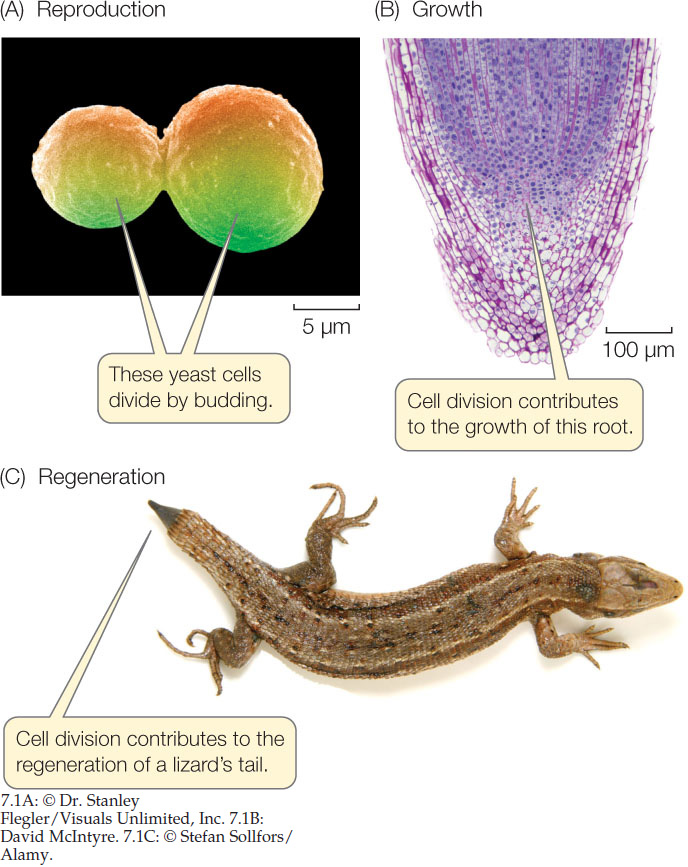Concept 7.1: Different Life Cycles Use Different Modes of Cell Reproduction
In Chapter 4 we described cells as the basic compartments of life, where biological processes are separated from the external environment. Cells are also essential for biological reproduction.
The life span of an organism from birth to death is intimately linked to cell reproduction, which is commonly referred to as cell division: a process by which a parent cell duplicates its genetic material and then divides into two similar cells. Cell division plays important roles in the growth and repair of tissues in multicellular organisms, as well as in the reproduction of all organisms (FIGURE 7.1). Although the details vary widely, organisms have two basic strategies for reproducing themselves: asexual reproduction and sexual reproduction. These two strategies make use of different types of cell division.

Asexual reproduction by binary fission or mitosis results in genetic constancy
Asexual reproduction is a rapid and effective means of making new individuals, and it is common in nature. The offspring resulting from asexual reproduction are clones of the parent organism—they are genetically identical (or virtually identical) to each other and the parent. Any genetic variations among the parent and offspring are due to changes called mutations, which are alterations in DNA sequence caused by environmental factors or errors in DNA replication (see Concept 9.3). This small amount of variation contrasts with the extensive variation possible in sexually reproducing organisms, as we will see later in this chapter.
In most cases, single-celled prokaryotes reproduce by binary fission, an asexual process that we will discuss in Concept 7.2. A cell of the bacterium Escherichia coli is the whole organism, so when it divides to form two new cells, it is reproducing. Similarly, single-celled eukaryotes (such as fission yeast) can reproduce asexually through mitosis followed by cytokinesis, processes that also produce two genetically identical cells (see Concept 7.2).
Many multicellular eukaryotes, including fungi and plants, can also reproduce asexually. Perhaps the most dramatic example of this is a forest containing thousands of aspen trees (Populus tremuloides) in the Wasatch Mountains of Utah (FIGURE 7.2). DNA analyses have shown that these trees are clones—they are virtually identical genetically. Aspen can reproduce sexually, with male and female plants, but in many aspen stands all the trees are the same sex and reproduction is asexual. An extensive root system spreads through the soil, and at intervals stems form and grow into new trees.

Sexual reproduction by meiosis results in genetic diversity
Sexual reproduction involves the fusion of two specialized cells called gametes, and can result in offspring with considerable genetic variation. In many diploid organisms, the gametes form by meiosis—a process of cell division (described in Concept 7.4) resulting in daughter cells with only half the genetic material of the original cell. During meiosis, the genetic material is randomly separated and reorganized so that the daughter cells differ genetically from one another. Because of this genetic variation, some offspring of sexual reproduction may be better adapted than others to survive and reproduce in a particular environment. Meiosis thus increases genetic diversity, which is the raw material for natural selection and evolution.
As we described in Chapter 4, the DNA in eukaryotic cells is organized into multiple structures called chromosomes. Each chromosome consists of a double-stranded molecule of DNA and associated proteins. In multicellular organisms, the body cells that are not specialized for reproduction are called somatic cells. In many familiar organisms, including most vascular plants and animals, the somatic cells each contain two sets of chromosomes, and the chromosomes occur in pairs called homologous pairs. One chromosome of each pair comes from the organism’s female parent, and the other comes from its male parent. For example, in humans with 46 chromosomes, 23 come from the mother and 23 from the father, with, for example, a chromosome 1 from each parent, and so on.
131
The two chromosomes in a homologous pair (called homologs of one another) bear corresponding, though not identical, genetic information. For example, a homologous pair of chromosomes in a plant may carry different versions of a gene that controls seed shape. One homolog may carry the version for wrinkled seeds, while the other may carry the version for smooth seeds.
LINK
The inheritance of characteristics such as seed shape is discussed in Concept 8.1
Gametes contain only a single set of chromosomes—that is, one homolog from each pair. The number of chromosomes in a gamete is denoted by n, and the cell is said to be haploid. During sexual reproduction, two haploid gametes fuse to form a zygote in a process called fertilization. The zygote thus has two sets of chromosomes, just as the somatic cells do. The chromosome number in the zygote is denoted by 2n, and the cells are said to be diploid.
In many familiar organisms the zygote divides by mitosis, producing a new, mature organism with diploid somatic cells (as we have just described). But some other organisms have haploid stages in their life cycles.
Sexual life cycles are diverse
All sexual life cycles involve meiosis to produce haploid cells. In some cases, gametes develop immediately after meiosis. In others, each haploid cell divides and develops into a haploid organism—the haploid stage of the life cycle—that eventually produces gametes by mitosis. The fusion of gametes—fertilization—results in a zygote and begins the diploid stage of the life cycle. Since the origin of sexual reproduction, evolution has generated many different versions of the sexual life cycle. FIGURE 7.3 presents three examples. The life cycles of a variety of organisms will be described in detail in Part 4. For now we will focus on the role of sexual reproduction in generating diversity among individuals.

Go to ACTIVITY 7.1 Sexual Life Cycle
PoL2e.com/ac7.1
132
The essence of sexual reproduction is the random selection of half of the diploid chromosome set to make a haploid gamete, followed by fusion of two haploid gametes from separate parents to produce a diploid cell. As we will see later in this chapter, further diversity is introduced by events that take place during meiosis. All of these steps contribute to a shuffling of genetic information in the population, so that no two individuals have exactly the same genetic constitution. The diversity provided by sexual reproduction opens up enormous opportunities for evolution.
CHECKpoint CONCEPT 7.1
- In terms of the genetic composition of offspring, what is the difference between sexual and asexual reproduction?
- Discuss the advantages of sexual versus asexual reproduction in terms of evolution. Could evolution proceed without sexual reproduction? Explain your answer.
We have briefly mentioned the different types of cell division and the roles they play in the life cycles of organisms. Now let’s look in more detail at the processes of cell division, starting with binary fission and mitosis.